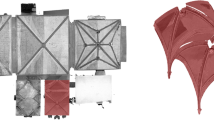Abstract
In this paper, a wild boar head was taken as the bionic research object for the development of new ridgers, a kind of plough. The reverse engineering technology was adopted to obtain the surface geometrical information of the head. Several three-dimensional (3D) point clouds of the head were captured first using a non-touch laser scanner, and an integrated point cloud was generated by aligning these point clouds using UG/Imageware. Then, the digital surface model of the head was rebuilt by means of CATIA. The characteristic curves of the surface model were analyzed. The results show that the average error between the rebuilt surface and the point cloud is −0.431 mm. The max curvature of the ridge on the neb of the head is 0.187 mm−1, and the max and min Gauss curvatures on the surface are 0.008 mm−2 and −0.002 mm−2. These geometrical information are the essential parameters for biomimetics study of the ridger.
Similar content being viewed by others
References
Ren L Q, Tong J, Li J Q. Biomimetics of machinery for soft terrain. Transactions of the Chinese Society of Agricultural Machinery, 2000, 31, 5–9. (in Chinese)
Li J Q, Sun J R, Ren L Q, Chen B C. Sliding resistance of plates with bionic bumpy surface against soil. Journal of Bionics Engineering, 2004, 1, 207–214.
Ren L Q, Tong J, Li J Q, Chen B C. Soil adhesion and biomimetics of soil-engaging components: A review. Journal of Agricultural Engineering Research, 2001, 79, 239–263.
Yang X D, Ren L Q. Types and mechanisms of shape drag reduction. Transactions of the Chinese Society of Agricultural Machinery, 2003, 34, 130–132. (in Chinese)
Xun B. Application of CATIA in design on the automobile. Machine Development, 1999, (3), 53–55. (in Chinese)
Chen Y F. Biological characteristic and taming. Contemporary Animal Husbandry, 2003, (5), 36–38. (in Chinese)
Li S W, Tong J, Zhang S J. Three-dimensional geometrical modeling of the exterior configuration of a cattle hoof by reverse engineering technology. Transactions of the Chinese Society of Agricultural Engineering, 2004, 20, 156–160. (in Chinese)
Liang S R, Lin A C. Probe-radius compensation for 3D data points in reverse engineering. Computers in Industry, 2002, 48, 241–251.
Wang G J, Wang C C, Chuang S H F. Reverse engineering of sculptured surfaces by four-axis non-contacting scanning. International Journal of Advanced Manufacturing Technology, 1999, 15, 126–134.
Zhang S J, Raja V H, Fernandes K J, Ryall C, Wimpenny D. Rapid prototyping models and their quality evaluation using reverse engineering. Journal of Mechanical Engineering Sciences, 2003, 217, 81–96.
Lee I K. Curve reconstruction from unorganized points. Computer Aided Geometric Design, 2000, 17, 104–112.
Fischer A. Multi-level models for reverse engineering and rapid prototyping in remote CAD systems. Computer-Aided Design, 2000, 32, 45–56.
Kruth J P, Kerstens A. Reverse engineering modeling of-free-form surfaces from point cloud subject to boundary conditions. Journal of Materials Processing Technology, 1998, 76, 120–127.
Zhang W, Jiang X F, Ma Y L. The error analysis and quality control of reverse engineering. Mechanical and Electrical Engineering Magazine, 2001, 18, 14–16. (in Chinese)
Author information
Authors and Affiliations
Corresponding author
Rights and permissions
About this article
Cite this article
Xu, L., Lin, Mx., Li, Jq. et al. Three-Dimensional Geometrical Modelling of Wild Boar Head by Reverse Engineering Technology. J Bionic Eng 5, 85–90 (2008). https://doi.org/10.1016/S1672-6529(08)60010-4
Published:
Issue Date:
DOI: https://doi.org/10.1016/S1672-6529(08)60010-4




